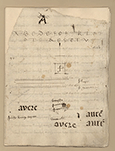THE DATINI's ARCHIVE

Francesco di Marco Datini, died, heirless, in his Prato home on 16 August 1410, leaving all his effects to the Ceppo poorhouse. And he left another vital memento of himself in the accounting registers and correspondence which became a substantial collection, today stored at the State Archives in Prato, the premises of which are in the merchant's ancient home.
Here is a collection of early medieval documents produced by the group of Datini companies in the years between 1363 and 1410.
Here is a collection of early medieval documents produced by the group of Datini companies in the years between 1363 and 1410.

The archival set, unique in its organic unity and consistency, highlights his authentic function of director who, from the apex of a sort of medium sized holding company, determined his actions and choices following careful analysis both within his companies and also in the economic milieu where his business was carried out.
When the accounts of every compagnia in his group were periodically closed, Datini had the books sent to him so as to be able to keep a further check on the activities effected and the results obtained. Together with the books, packets of all correspondence received were also sent.
When the accounts of every compagnia in his group were periodically closed, Datini had the books sent to him so as to be able to keep a further check on the activities effected and the results obtained. Together with the books, packets of all correspondence received were also sent.
The Datini companies' accounting, almost all of it in double entry, was continually subjected to innovation in procedure over the documented period, making improvements which would allow a more efficient control.
The contents, besides being of benefit to internal study of the companies, show how new commercial or financial practices and instruments took hold, characterising the business of Tuscan merchants in the second half of the fourteenth century.
The contents, besides being of benefit to internal study of the companies, show how new commercial or financial practices and instruments took hold, characterising the business of Tuscan merchants in the second half of the fourteenth century.

The commercial correspondence is rich in information on this subject and it formed an indispensable tool for the merchant, so that he was informed in due time about anything that could concern market trends either directly or indirectly.
Apart from strictly economic information concerning the functioning of the market place, price and exchange trends, etc., we find other details of political, social, cultural, artistic or religious interest. Information which we not only come across in the correspondence between the firms belonging to the same group, but often between rival companies, too.
Apart from strictly economic information concerning the functioning of the market place, price and exchange trends, etc., we find other details of political, social, cultural, artistic or religious interest. Information which we not only come across in the correspondence between the firms belonging to the same group, but often between rival companies, too.

The more this material is concentrated in time and the more geographically spread out it is, the more notable its importance and utility is. The variety of economic centres with which the Datini system was in contact is demonstrated by the number and typology of the senders. Though the greater number of letters came from the more important English, Dutch, German, French, Spanish and Italian commercial centres, the 267 towns represented lie within a perimeter bordered by the cities of Bristol, Lisbon, Safi, Mecca, Tana, Varna, Ragusa, Nuremberg and Cologne.
The forty-year period documented in the Datini collection (but 80% of the documents refer only to the last 20 years) displays 1194 pieces, 602 of which are accounting ledgers and 592 are envelopes of correspondence, containing about 150.000 letters.
The forty-year period documented in the Datini collection (but 80% of the documents refer only to the last 20 years) displays 1194 pieces, 602 of which are accounting ledgers and 592 are envelopes of correspondence, containing about 150.000 letters.

Of these, 574 codices and 497 envelopes are distributed throughout the eight Datini fondaci (Avignon, Prato, Pisa, Florence, Genoa, Barcelona, Valenza and Majorca), whilst the remaining 28 ledgers and 95 envelopes are collected together in a sector on its own of "sundry documents".
The five centuries have been crossed with minimal loss by this archive. Losses occurred at the beginning, with regard to the Avignon letters, 95% of which were lost during the transport to Pisa. Damage to the ledger series (under 10%, at least regarding the last twenty years) are almost totally compensated for by the coexistence of collateral books.
The five centuries have been crossed with minimal loss by this archive. Losses occurred at the beginning, with regard to the Avignon letters, 95% of which were lost during the transport to Pisa. Damage to the ledger series (under 10%, at least regarding the last twenty years) are almost totally compensated for by the coexistence of collateral books.

The happy circumstance that the correspondence has survived in its entirety is principally due to the administrators of the charitable institution of the Ceppo poorhouse who deposited the whole, immense documentation, without mishandling it, in some room in disuse. In 1560, after about a century, a scholar from Prato, Alessandro Guardini, took an interest in the Datini papers, arranging them in some kind of order. But in the seventeenth century, when the palazzo underwent alterations and restoration, the documents, tied into parcels, were put to one side on a "blind flight of steps", lying there forgotten until they were found again at the end of the nineteenth century.